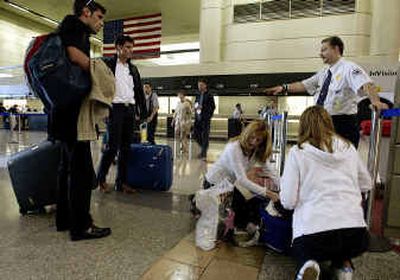GAO: Airport security incomplete

WASHINGTON – The government’s efforts to prevent terrorists from gaining access to commercial airports are still incomplete and fragmented, a congressional report says.
The Transportation Security Administration has focused on screening passengers and baggage while paying less attention to limiting access to sensitive areas, identifying gaps in security and reducing risks posed by airport workers.
“Airports remain too vulnerable to terrorist attack,” said Sen. Joe Lieberman, D-Conn., who requested Tuesday’s report from the General Accounting Office, Congress’ investigative arm. “This level of unpreparedness is unacceptable.”
Lieberman said he was especially concerned that the TSA doesn’t require airport employees to be screened before entering secure areas such as runways.
About 1 million people work at about 450 U.S. commercial airports, including catering employees, refuelers, cleaning crews and baggage handlers. The TSA has made sure that nearly all of them have had their criminal histories checked against their fingerprints.
But some workers who occasionally need access to secure areas – such as construction workers – haven’t undergone the fingerprint checks, even though the law requires them to.
The GAO report recommended more comprehensive checks because those based on fingerprints have limitations. For example, a federal investigation after the Sept. 11, 2001, terror attacks found that more than 4,200 airport workers had falsified information to get hired and to get unescorted access to secure areas. Some had passed the fingerprint-based checks.
The TSA has expanded background checks for about 100,000 airport workers to look for links to terrorism, and is considering ways to fund additional checks for more.
But the agency is not requiring airport workers to be screened before entering restricted areas, as the law requires.
The agency has inspected airports – the exact number is classified – to determine the adequacy of such security measures as fences, surveillance cameras, sensors to detect intruders or fingerprinting equipment.
Last year, the TSA identified threats to the security of the perimeter and access controls at each airport it inspected, the report said.
Between October and February, the agency issued 106 warning notices and 123 letters of correction, which requires airports to take immediate action to avoid a penalty. The agency also recommended 67 civil penalties.
But the GAO said the agency hasn’t analyzed whether those penalties were effective, nor does it have a plan to continue further inspections.
The TSA suspended the inspections in January so it could deal with a higher priority: assessing airports’ vulnerability to shoulder-fired missiles.
The TSA also missed a Congressional deadline of May 2002 to recommend technologies to prevent unauthorized access to secure parts of airports. It missed another deadline a year later to develop a strategy to acquire commercially viable security technology at the 20 biggest U.S. airports.
Some airports told the GAO they were waiting for TSA guidance to upgrade their security. Others said they were going ahead and testing various technologies independently of the TSA.